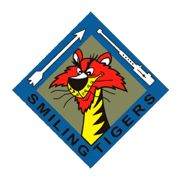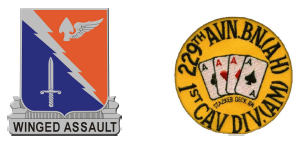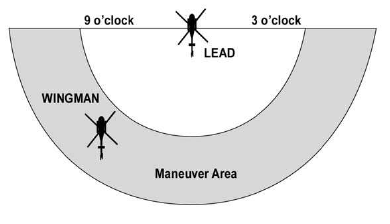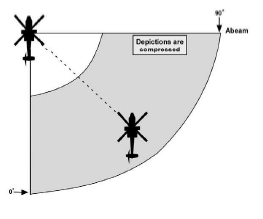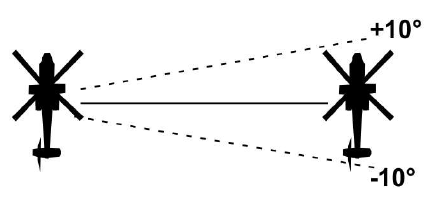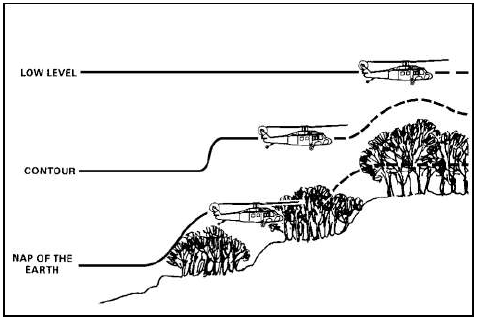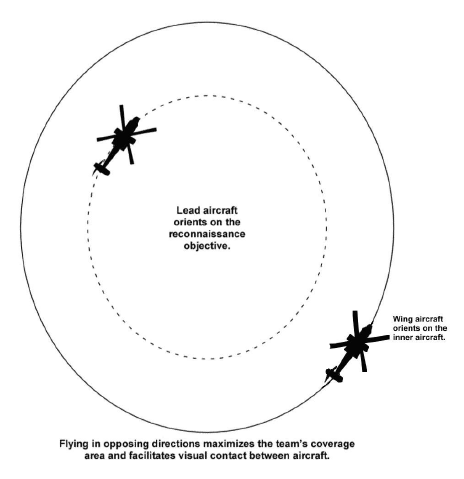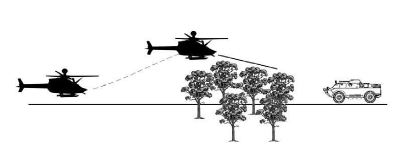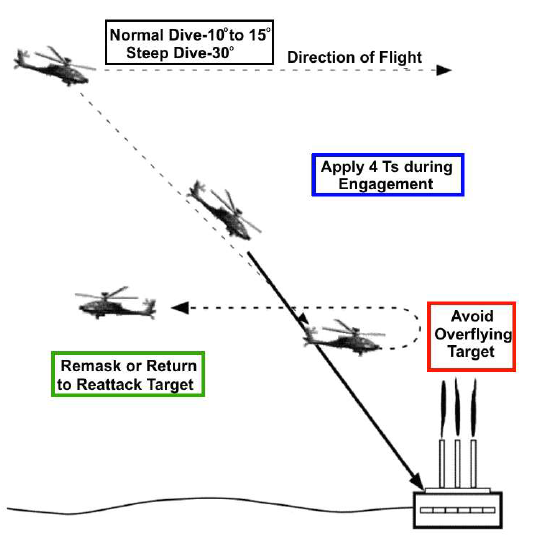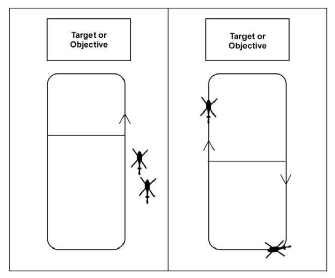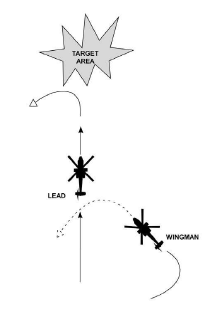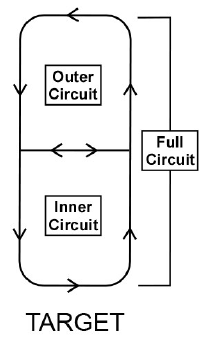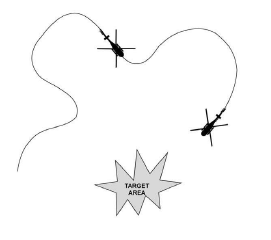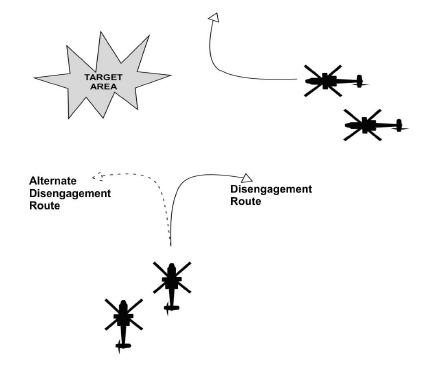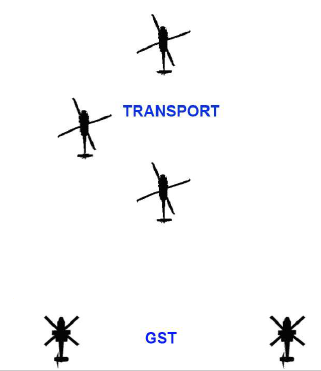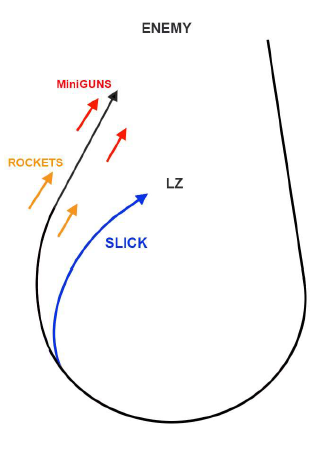Difference between revisions of "Gunnery"
(Created page with "File:D229.png File:229AHB_logo.png '''D Company 229 AHB''' D Company (Aerial Weapons) H Troop (16th Cavalry Regiment) '''Basic Operations''' This document outli...") |
(No difference)
|
Latest revision as of 05:59, 20 February 2020
D Company 229 AHB
D Company (Aerial Weapons)
H Troop (16th Cavalry Regiment)
Basic Operations
This document outlines the basic tactical procedures for D Company (Aerial Weapons) & H Troop (16th Cav) operations within the virtual 229th (AHB) It will be assessed periodically and revised if necessary.
Contents
- 1 Team Deployment
- 2 Team Tasks
- 3 Individual Tasks
- 4 Movement
- 5 Team Manoeuvring
- 6 Modes of Terrain Flight
- 7 Masking & Unmasking
- 8 Reconnaissance Techniques
- 9 Reconnaissance Methods
- 10 Forms of Reconnaissance
- 11 Attack Methods
- 12 Firing Techniques
- 13 Weapon Delivery
- 14 Team Attack Pattens
- 15 Situational awareness & Communication
- 16 Aerial Escort
- 17 Air Assault / Troop Insertion
- 18 Escort & Assault Communication
- 19 References:
Team Deployment
D Company Gunships and H Troop Scouts in many roles fly in pairs consisting of a lead and a wingman. Lead is generally the most proficient PC in the team and is selected based on ability and demonstrated knowledge of missions, tactics, and 229th SOPs.
This position does not interfere with the normal command and control of the mission but does allow the most experienced PC to manoeuvre the team and engage using proper tactics, formations and weapons delivery techniques,
The wingman’s primary responsibility is to cover the lead aircraft. Often the wingman may be the commander who serves as AMC. The AMC provides critical tactical leadership and decision making and is overall responsible for the team or flight.
Team Tasks
- Executes forward and left/right sector security
- Transmits alerts for obstacle avoidance
- Executes basic combat manoeuvres (BCMs) as required to engage or bypass threats
- Transmits target reports to wingman/flight
- Conducts attacks or suppression of air defence units
- Maintains briefed separation from lead and other teams
Individual Tasks
Lead
- Primary for selecting routes and tactics
- Provides navigation and timing.
- Conducts destruction of ADUs or selection of bypass route
- Coordinates direct fire engagements with the ground forces.
- Update AMC on status
- Selects appropriate method of attack
- Selects appropriate ordinance for weapon target pairing
- Selects appropriate attack pattern for target
- Gives attack brief to wingman and flight if required
- Provides updates to commander
Wing
- Provides cover/security for lead
- Provides backup navigation and timing
- Provides destruction of AD for team
- Covers lead.
- Makes initial contact with ground forces and prioritises engagements.
- Provides calls for fire.
- Conducts coordination for CAS
Movement
Travelling Overwatch
Company elements employ travelling overwatch when speed is essential and enemy contact is possible. This technique is normally associated with reconnaissance, security, and attack missions when threat and/or environmental conditions preclude use of bounding overwatch. Lead aircraft or teams move constantly and trail aircraft or teams move as necessary maintaining overwatch of lead.
Overwatching aircraft key their movement to terrain and their distance from the main element. It also remains ready to fire or manoeuvre, or both, providing support to main elements. Units often employ contour or NOE flight with the travelling overwatch technique using high and varying airspeeds depending on weather, ambient light, and threat.
Bounding Overwatch
Company elements employ bounding overwatch when they expect enemy contact and the greatest degree of concealment is required.
It is the slowest movement technique; too slow for high tempo operations and vulnerable for non-linear and/or urban operations. Individual aircraft or aircraft teams employ alternate or successive bounds.
One element remains in position to observe, fire, or manoeuvre before the other element moves.
Overwatching elements cover the progress of bounding elements from a covered and concealed position, which offers observation and fields of fire against potential enemy positions.
The length of the bound depends on terrain, visibility, and effective range of the overwatching weapon system.
Units normally employ contour and NOE flight with bounding overwatch technique. Airspeed during each bound is varied depending on availability of vegetation and terrain for concealment.
Team Manoeuvring
Manoeuvrability is a prime consideration for Gunship operations.
The following formations allow lead to maintain formation integrity, yet manoeuvre with few restrictions. Wingmen must maintain a position that will not hamper lead’s ability to manoeuvre while providing their own horizontal and vertical clearance.
Variations in altitude may be advantageous based on METT-TC. The high-low concept in conjunction with the movement technique may provide more flexibility to the team, especially in the urban environment. Wing may increase his altitude commensurate with the threat to utilise the potential energy of altitude to build airspeed during a diving attack. This provides a more stable gun platform and greater manoeuvrability for egress off the target.
Over open terrain or during high illumination, greater spacing is used to increase survivability and flexibility. Formation spacing becomes tighter in rough terrain or reduced illumination/visibility. It is important to avoid flying over the same spot on the ground; variations in flight path between aircraft should be the norm. The mission dictates aircraft separation and team separation.
Aircraft and team separation may range from 3-5 rotor disks to 1 kilometre or more. Primary concern when establishing separation is METT-TC and the ability to provide mutual support.
The basic Gunship formations are combat cruise, combat cruise left and right, and combat spread.
Combat Cruise (sometimes referred to as ‘Free Cruise’)
Combat cruise is used when teams wish to move quickly and maximize use of terrain for masking. Combat cruise allows the wingman flexibility in manoeuvring the aircraft left or right of the lead aircraft’s centreline.
The wingman should never track in straight trail as it limits forward observation and the ability to provide suppressive fires for lead. It also increases the possibility that the lead’s presence has alerted the enemy to the wingman’s flight path.
Separation should be 150 meters or more depending on terrain and threat.
Combat cruise formation is—
- Preferable at very low altitudes for long flights breaking up the predictability of the formation and permitting optimal terrain flight using masking terrain.
- Preferable during day and high visibility weather when small arms fire threat is substantial.
Combat Cruise Right/Left
Unlike combat cruise, combat cruise right/left requires the wingman remain in either right or left cruise and change sides only after coordinating with the lead aircraft.
Using combat cruise right/left, the wingman remains in an arc 0 to 90 degrees aft abeam of lead to the left or right side.
Optimum position is 45 degrees. Separation should be 150 meters or more depending on terrain and threat.
Observation sectors are divided between lead and wing providing overlapping observation and fire.
Combat cruise right/left formation— • Is preferable at very low altitudes for long flights breaking up predictability of formation and permitting optimal terrain flight using masking terrain. • Is preferable to combat cruise when weather and night vision systems are marginal, but threat is still high. • Can be used at night for larger formations as an alternative to echelon when NVG are used.
Combat Cruise WIDE
In DCS during daylight it is frequently difficult or impossible to see from within the cockpit AAA gun or cannon fire directed at you until the aircraft is terminally damaged.
At best you may be aware of tracer flying past the cockpit but unless the attacker is clearly near and visually obvious, its location will not be seen.
However, this tracer fire is often seen by an element located at least 100m or more off to one side, the further away the better the degree of visibility.
In order to improve survivability in areas known or suspected to have AAA capability, WING will adopt Combat Cruise WIDE, left or right dependent on anticipated break or egress direction.
This position should be slightly higher than, and as far to one side of LEAD as possible, whilst still maintaining visual contact - ideally at the 4 or 8 o’clock position.
This will best facilitate either LEAD or WING recognising incoming tracer AAA, calling break to the targeted element and noting the tracer source position.
Normally both LEAD & WING will break, re-form and plan an attack if appropriate.
Combat Spread
Combat spread promotes security by providing maximum fire-power forward and overlapping fields of view (FOVs).
When flight lead announces combat spread, he includes the command left or right.
Wingmen should move toward that abeam position, either lead’s 3 or 9 o’clock position.
Flying in combat spread requires a rapid scan to maintain situational awareness of the other aircraft as well as approaching terrain; this requires even more vigilance at night.
For planning, the wingman should maintain approximately ten rotor disk separation from the lead aircraft.
Team leaders may vary the maximum lateral separation between aircraft based on visibility, manoeuvre space available, and expected enemy weapon ranges.
Combat spread formations:-
- Can be used when maximum observation to the front is desirable or when attempting to limit exposure of the flight when crossing open areas.
- May be used en route to minimise vulnerability of trail aircraft.
- Are not advised for use in the objective area when constant manoeuvring is required.
- Increase pilot workload to maintain formation, especially under night vision systems.
Modes of Terrain Flight
Terrain flying includes appropriate tactical application of low-level, contour, and NOE flight techniques as appropriate, diminishing the enemy’s capability to acquire, track, and engage aircraft.
Terrain flight requires aircrew proficiency in map reading, preparation, and terrain interpretation and requires constant vigilance in identifying terrain features and hazards.
Continuous NOE or contour flight is unusual because terrain and vegetation vary. Normally, there is a transition from one mode to the other as the situation dictates. Modes of terrain flight are defined below.
Nap-of-the-earth flight
NOE flight is conducted at varying airspeeds as close to the earth’s surface as vegetation and obstacles permit. Aviators should decrease airspeed if weather and ambient light restrict visibility.
- Altitude and airspeed will vary according to the factors of METT-TCS. Enemy contact IS expected.
- Altitude should not exceed 25 feet above highest object (AHO)
- Airspeed should not exceed 40KIAS
Contour flight
Contour flight is conducted at low altitude conforming to the earth’s contours.
It is characterized by varying airspeeds and altitude, dictated by the terrain and obstacles.
Aviators should decrease airspeed if weather and ambient light restrict visibility.
- Used for Travelling or Travelling overwatch techniques of movement.
- Enemy contact is possible
- Low altitude conforming to the surface of the earth
- Airspeed not to exceed VNE
Low-level flight
Aviators perform low-level flight at constant altitude and airspeed, dictated by threat avoidance.
Aviators should decrease airspeed if weather and ambient light restrict visibility.
- Constant airspeed and indicated altitude
- Travelling technique of movement
- Enemy contact is NOT likely
- Minimum altitude 50 feet AHO
- Airspeed not to exceed VNE
Masking & Unmasking
Masking is a technique utilising terrain to mask (cover or conceal) the aircraft from threat detection and weapons employment.
Unmasking is a manoeuvre used when it becomes necessary to observe points of interest that are obscured while in a masked position.
Before unmasking, a thorough map reconnaissance should be completed so that all eyes can be focused outside during the unmasking.
The three general types of unmasking are as follows:
Unmasking in flight
This type is used when the aircraft has forward speed and can best be described as a quick "pop up and peek" at the desired point or area of observation.
It is usually used while flying behind a ridge-line or other linear barrier.
Unmasking at a hover (vertically)
Moving the aircraft vertically from a hover position behind a feature.
When possible, unmask at a safe distance from the mask to allow a rapid descent to a masked condition if the aircraft is detected or fired upon.
Be aware of a common tendency to move forward or rearward while vertically unmasking and re-masking.
Establish reference points to assist in maintaining position during ascents and descents and keep aircraft exposure time to a minimum.
Unmasking at a hover (laterally)
Sometimes, the aircraft may be unmasked by moving laterally from the feature to provide the smallest silhouette possible to enemy observation or fire. Keep aircraft exposure time to a minimum.
Reconnaissance Techniques
Actions on Contact
Actions on contact relate to encountering a threat force or situation that warrants or demands action.
At team level, actions on enemy contact consist of the following three steps:
- Deploy to cover and report.
- Maintain contact and develop the situation.
- Choose / recommend / execute a COA
The team that makes initial contact with the threat immediately conducts basic combat manoeuvring, suppresses as necessary, and deploys to terrain that affords them both cover and good observation.
It may not always be possible to deploy to cover and maintain observation, especially in complex terrain.
Maintain Contact and Develop the Situation
The team in contact further identifies the threat. The team manoeuvres to determine the threat size, composition, orientation, and exact location of weapon systems. The team may also use the reconnaissance-by-fire method to determine the threat’s tactical intentions.
Choose a Course of Action
Once the enemy situation has been developed, the team leader determines the best COA within the commander’s intent, concept of the operation, and team’s capabilities. Resuming the mission as soon as possible is normally the main criteria for COA selection.
The possible COA may be—
- Hasty attack. The team leader can conduct a hasty attack if the target meets the
engagement criteria for the mission, and the team possesses sufficient combat power to defeat the threat quickly. In most cases, the team does not have the capability to defeat a threat in prepared positions and is normally under specific instructions not to become decisively engaged.
- Bypass. If the team chooses to remain undetected and continue the reconnaissance
mission, the team may manoeuvre to bypass the enemy. The team leader must receive the commander’s permission (either verbally or as stated in the OPORD) to bypass any elements.
- Hasty screen. If the team cannot conduct a hasty attack and cannot bypass, it establishes a
hasty screen and maintains contact through observation. The team concentrates on maintaining contact with the threat by fixing it in place with indirect, or possibly direct, fire until additional support comes from the company or other unit.
- Support by another team.
Reconnaissance Methods
Aerial Reconnaissance
H Troop uses this method in most of its reconnaissance efforts. It is characterized by:
- The need for rapid reconnaissance.
- The use of aircraft systems to acquire targets or reconnaissance objectives at maximum stand-off distance.
- Use of on-board video imagery to acquire the combat information.
- Low probability of enemy air defence artillery (ADA) threat.
- The integration of aerial reconnaissance assets and sensors with forward ground elements to accelerate reconnaissance tempo and movement.
- The requirement to maintain reconnaissance over extended distances.
The advantages of aerial reconnaissance are available fire power, manoeuvrability, advanced optics, navigational aids (NAVAIDs), and communication capabilities. The disadvantages are the larger overall signature and exposure of aircraft.
- Aerial reconnaissance tasks may include:
- Conduct as part of integrated air-ground (and eventually manned/unmanned) team to–
- Avoid meeting engagement.
- Develop the situation out of contact.
- Identify HPT’s
- Enable freedom of manoeuvre.
- Enhance force protection.
- Apply fundamentals of reconnaissance.
- Execute actions on contact to fix, destroy, or disengage as required.
Reconnaissance by Fire
Reconnaissance-by-fire is a method employed to find specific threat locations. When conducting reconnaissance-by-fire, the Scout Team places direct and/or indirect fire on suspected threat positions. The intent of reconnaissance-by-fire is to cause the threat to move or return fire, thus to disclose its exact location.
This technique is appropriate when time is critical and stealthy manoeuvre to further develop the situation is not possible. The fires may be either direct, indirect, or a combination. The advantages of indirect fire are it does not give away friendly locations and usually causes the threat to displace from the impact area.
The disadvantages are it effects obscure observation and should not be used in close proximity to friendly units, structures of tactical or political importance, and non-combatants.
Reconnaissance by fire may not cause a seasoned or prepared threat force to react.
Reconnaissance by fire is always characterized as aggressive and is used when:
- Situation meets liberal engagement criteria.
- Time is critical.
- A threat position is suspected.
- Natural or manmade obstacles.
- Obvious kill zone.
- Signs of recent enemy activity.
- Future friendly positions (BP/ABF/SBF/AA/HA) prior to occupation.
- Threat locations are known.
The reconnaissance by fire technique has other advantages and disadvantages. It is more advantageous with a poorly disciplined threat that will likely react when engaged. The disadvantages of reconnaissance-by-fire are the obvious loss of surprise, exposing the location of the firing element, and the possibility of becoming decisively engaged. When the ARC employs this technique, the available weapons are normally used in the following priority:
- Indirect fire.
- Machine gun and/or rockets.
- (Hellfire) missiles last.
Forms of Reconnaissance
Route Reconnaissance
A route reconnaissance is conducted to obtain information about a specific route and all adjacent terrain from which the threat could influence movement along the route. The reconnaissance may be oriented on a road, axis, air route, specific LOC, railway, cross country mobility corridor, or general direction of advance or attack.
Air Route Reconnaissance
The principles of an air route reconnaissance are the same as for a ground route, but the areas of interest are different. Aviation forces moving along an air route are primarily concerned with the location of enemy forces, ease of navigation, suitable landing sites and zones, and hazards to flight. Hazards to flight include suspected enemy AD locations, mountainous areas, wires, large bodies of water, open terrain, and ot her natural and man made features.
Zone Reconnaissance
A zone reconnaissance is a directed effort to obtain information concerning all routes, obstacles (to include CBRN), terrain, and enemy forces within a zone defined by boundaries. The boundaries of a zone are restrictive, unlike those of an area reconnaissance, which are permissive. ARCs require permission from the ground commander to extend their reconnaissance outside of the zone’s boundaries. It is the most time-consuming of the reconnaissance missions, so the company must allow for adequate time to plan and execute. A zone reconnaissance is frequently conducted over an extended distance, which dictates special considerations for team employment.
Area Reconnaissance
The purpose of an area reconnaissance is to gather intelligence or conduct surveillance of a specified area. The area may be key terrain, a farm, bridge, ridge line, wooded area, proposed AA, LZ, or other features that will be critical to an operation. The specified area to be reconnoitred is designated by boundary lines enclosing the area. METT-TC determines the movement technique the air reconnaissance team uses to reach the area and the method by which the area is systematically reconnoitred. The air reconnaissance team also reconnoitres dominant terrain outside the specified area from which the threat can influence friendly operations.
Aerial Surveillance
Although primarily a mission for UAS, the ARC may be tasked with conducting surveillance. Aerial surveillance is defined as systematic observation to obtain detailed information of a specific target or area. The focus of surveillance is generally a point target such as a house, car, section of road, or any other defined area with specific threat indicators to trigger PIRs. ARCs use the same fundamentals to conduct surveillance as with any reconnaissance mission. When performed by the ARC, surveillance is normally overt in nature with the purpose of deterring enemy movement or activity.
Attack Methods
Gunships may employ different attack methods to engage the enemy and these are generally classed as:
High attack
High attack is used during diving fire when aircraft are required to maintain higher altitudes, normally greater than 1,000 feet. This technique is especially useful for following targets through urban areas and allows for remote engagements.
Other advantages include aircraft remain above accurate small arms fire while retaining energy for manoeuvre, allows for greater target identification within urban areas or restrictive terrain, and minimises weapon’s effects dispersion.
A disadvantage is the higher altitudes enable greater effectiveness of some threats such as missiles.
Low-level attack
Low-level attack is used when the aircraft is required to maintain near terrain or NOE when engaging
a target; normally used during hover or running fire.
An advantage of this technique is the aircrew’s ability to maintain a lower profile that is masked by background terrain or vegetation making it difficult for the enemy to judge closure.
A disadvantage is the aircrew cannot engage the target at maximum range of the weapons system due to targeting hindered by a level viewing angle. Additional disadvantages include limited LOS, decreased accuracy (both initial and subsequent rounds), and wider dispersion resulting in decreased weapons effect and increased chances for fratricide and collateral damage.
Bump or pop-up attack
The bump or pop-up attack is used to take advantage of masking terrain while increasing the angle
of attack; normally used during running fire, transitioning to diving fire. Each aircrew pops up up prior
to or during weapons engagement and then returns to terrain flight altitude. Advantages of this
technique are the aircrew’s increased ability for longer distance engagements, dispersion of
weapon’s effects is deceased, look-down angle is increased making target identification easier, and
aircraft momentum is maintained for manoeuvre.
Disadvantages include silhouetting of aircraft on horizon during bump, and excessive bump reduces airspeed and energy for manoeuvre.
Firing Techniques
Firing helicopter weapons systems requires a great deal of skill by the pilot. These skills require constant development and sustainment and include aircraft control and burst on target.
Aircraft Control
Aircraft control is most critical when engaging targets with rockets. Rockets are affected by changes in pitch attitude and relative wind as they leave the launcher. Regardless of the engagement technique used, aircrews should use a consistent sequence.
This sequence is known as the 4 Ts (target, torque, trim, target). The use of this sequence, regardless of your aircraft type, will assure a consistent launch. The following is a description of the sequence.
Target
Verify that the correct target is being engaged. Verify the correct azimuth. The pilot may select key terrain to assist in lining up on the target.
Torque
Verify that the torque required to maintain altitude and DO NOT CHANGE IT. Any torque changes during the firing sequence will affect the distance the rockets fly based on the changed induced flow from the rotor system.
Trim
The trim of the aircraft includes both horizontal and vertical trim. During hovering fire, the pitch attitude (vertical trim) should be verified for the range and adjusted with the cyclic. During running fire the trim of the aircraft (horizontal trim) should be verified and adjusted for with the pedals prior to firing. An out of trim condition will cause a deflection of the rockets on the opposite side the trim error occurs.
Target
Finally, check the correct target and azimuth prior to firing.
Burst on Target
BOT is the technique used to adjust fires on target. This technique requires the crew member firing the weapon to sense the impacts of his engagement and use proper technique to adjust the rounds on target.
BOT is used with cannon, machine gun, and rocket engagements. There are several techniques for applying BOT but for the UH-1H the most common is the Recognition method also known as “Kentucky Windage."
This technique's effectiveness is directly proportional to the experience of the Pilot making the corrections. An adaption for DCS UH-1H is:
- the pilot uses his experience to estimate the distance to target
- using the Pilot Sight in default range setting, select an aim-off point based on experience to adjust for distance
- fires a burst or 1 rocket salvo
- sees the impact
- estimates the amount of correction needed to adjust weapon used to be on target
- add or subtract the necessary adjustment aim-off and continues firing
- using visual feedback constantly adjust this aim-off differential as distance to target reduces
Weapon Delivery
Gunships use different delivery techniques to engage the threat. These delivery techniques can be divided into three modes - hover fire, running fire, and diving fire.
- Hover fire is any engagement conducted below effective translational lift (ETL). It may be either stationary or moving.
- Running fire is an engagement from a moving helicopter above ETL. Forward airspeed adds stability to the helicopter and increases the delivery accuracy of weapon systems, particularly rockets.
- Diving fire is a direct-fire engagement from a helicopter that is in a diving flight profile according to the aircraft ATM. The airspeed and altitude of the aircraft improve the accuracy of engagements, particularly for rockets.
Hover fire
Hover fire is fire delivered when the helicopter is below effective translational lift, either in ground effect or out of ground effect. It may be stationary or moving, but movement during hover fire is always below ETL airspeed. With the UH-1H hover fire is only possible using the Reflex Site (Co- Pilot position) or Side Gunner position.
The "4 Ts" from above apply to hover fire. Vertical and horizontal trim are important when engaging from a hover. Depending on the environmental conditions, many aircraft hover OGE very near their maximum torque available limit. The narrow power margin held by a loaded aircraft makes smooth, deliberate pilot inputs critical.
When firing at a hover, verify proper torque control by setting the collective and verifying that the vertical speed indicator is steady. Pitch of the aircraft should be confirmed with the attitude indicator.
Keep the aircraft stable for the most accurate shots. Drift with the wind if the threat situation and terrain permits.
When firing from a hover, the attitude of the aircraft may prevent the pilot from seeing directly over the nose of the aircraft. The pilot should select reference points identifiable from the aircraft to maintain aircraft alignment and position over the ground during the engagement.
Running Fire
- The crew selects an initial point about 8 to 10 kilometres from the target. The IP should be an identifiable terrain feature. The IP is selected primarily as a function of the desired route to the target.
- The aircraft departs the IP toward the target flying contour, using terrain to mask the approach.
- Approximately 6 km from the target, the pilot starts a climb to achieve intervisibility with the target. Once the crew acquires the target, the pilot levels the aircraft.
- At 5 km (rockets) or 1500 m (cannon) from the target, the pilot starts a shallow 3-to 5-degree dive angle and the crew begins engaging the target.
- At 3 km (rockets) or 1 km (cannon) from the target, the pilot begins his break and uses terrain to cover his deparure from the target area.
- The crew returns for an immediate reattack on the target or returns to the IP and holds.
- The aircraft does not fly over the target in running fire.
Diving Fire
The diagram below shows diving fire.
Use diving fire when
- High volume of accurate rocket and cannon fire is required on the target and there is minimal air defense threat.
- Use the 4 Ts (target, torque, trim, target). Proper aircraft control will greatly enhance the accuracy of the aircraft weapon systems, primarily with rockets.
- Engage targets with rockets and cannon similar to techniques used in running fire. Use rockets employing point detonating fuses and used "fixed gun" for cannons during the engagement.
- Use a careful cross-check because target fixation may cause the pilot to fly the aircraft into the ground. The pilot should complete the recovery from the dive no lower than 500 feet AGL for training.
- Pilots must monitor rate of closure, rate of descent, and torque.
- Understand that high rates of descent coupled with high flight path speeds require that the pilot closely monitor rate of closure and terrain features. The pilot must plan the dive recovery in time to avoid abrupt recovery maneuvers. If an abrupt recovery is attempted at high airspeed, "mushing" may occur. When the pilot tries to recover from a dive, the high rate of descent and high power setting cause the controls of the helicopter to become less responsive. Mushing may prevent the pilot from recovering the aircraft from the dive.
- The crew should avoid flying over the target in diving fire.
Team Attack Pattens
Teams utilise attack patterns to maximize weapons effectiveness and minimise exposure to the threat. Factors affecting the selection of attack patterns include type/size of threat, ordnance to be fired, available attack lanes, weapons delivery technique, and location of friendly forces. Examples of attack patterns utilised by the SWT are racetrack pattern, L attack, and cloverleaf attacks.
The AMC modifies the timing of the attack run to provide for a simultaneous or continuous attack
This is accomplished by adjusting the spacing between lead and wingman or the timing of the attack runs between multiple teams.
Simultaneous Attack
A simultaneous attack is executed from combat spread or combat cruise formation and is normally utilised when taking fire from the target area. Wingman’s attack is timed to provide suppressive fire for lead’s break-off of the target.
Example of simultaneous and continuous attacks
Wingman may also fly roughly 45 degrees offset from lead on the side opposite lead’s break. This permits suppression of the target area while lead is engaging and facilitates rapid disengagement from the attack run.
Wingman should maintain greater stand-off during attack run because lead cannot provide coverage. Ideally, aircrews vary the direction of the attack after each turn.
Continuous Attack
- A continuous attack separates team movement with only one team member inbound to the target area at a time.
- This technique is normally employed when the threat to the team is low or constant fire is desired on the target area.
- A continuous attack requires greater control and timing; lead should maintain an established airspeed in order for wingman to maintain proper spacing.
- Once this relationship is understood, modifications of the break line, speed, and delivery techniques may be made.
Race Track Pattern
- The racetrack pattern is divided into three circuits based on weapon system capabilities and average attack speed.
- Teams adjust distance to targets as necessary based upon METT-TC.
- The three circuits are full, outer, and inner .
- Full circuit. : Provides maximum stand-off and is primarily used for missile engagements.
- Outer circuit. : Outside enemy crew-served weapons range and allows gun, rocket, and missile delivery; accuracy is reduced for gun and rocket engagements.
- Inner circuit. : Outside enemy small arms range and enables gun and rocket engagements with best accuracy.
Cloverleaf Attack Pattern
- The cloverleaf pattern is a basic variant to the racetrack pattern and eliminates the predictability caused by multiple attack runs from the same direction.
- Number of leaves flown, engagement range, and timing are all flexible.
- When utilised with multiple teams the enemy is confronted with a high volume of fire from constantly changing directions.
- Care must be taken to avoid firing into other teams or overflying the target(s).
L-Attack Pattern
- The L-attack pattern is used to attack a target requiring a large volume of fire for a short duration utilizing two Gunship Teams.
- This pattern is capable of attacking linear targets masked by high terrain or obstacles on one side.
- Timing between teams is critical to provide simultaneous fire against the target.
- If a large volume of fire is not required both teams can establish racetrack patterns, and proper timing allows one helicopter at a time to provide neutralization fire.
‘Figure ‘8’ Patten
- The ‘Figure 8’ patten is where 2 UH-1h gunships with door guns fly opposing sides of a figure ‘8’ patten and the door gunners maintain continuous suppressing fire at an enemy which must be positioned on one side of an LZ only.
- Good visual and communication skills are necessary for deconfliction as both craft fly alternating left / right turns criss crossing in a small area.
Random Patten
Often the terrain and position of the enemy does not lend itself to a symmetrical pattern, so the GST may establish a pattern conforming to the situation.
Situational awareness & Communication
It is important to maintain situational awareness throughout engagements by ALWAYS reporting initially saddled, blind, visual etc.
In combat, all communications are to be short, clear and concise using standardised terms.
- i.e. LEAD: “mortar team, 11 o’clock, 100m South of tree line, cloverleaf attack, left turns”.
In intense combat situations visual contact amongst the team may be difficult. De-conflict and maintain situational awareness by frequent calls of C/S, Direction & Altitude until visual or flight order resumed.
i.e. :“2, Heading South, 300’, climbing” :“1, Inbound Heading South at 1000” :“2, 1500’, Tipping In, heading South”
Aerial Escort
Aerial escort missions are flown to protect helicopters conducting air assault, MEDEVAC/CASEVAC, or air movement missions.
Escorted formations may range from a single aircraft to a large air assault formation.
The purpose of this mission for the Gunship Team (GST) is to protect the escorted formation by locating the enemy before they can affect the flight or by deterring enemy fire. If the escorted flight is engaged the GST must react quickly to destroy, neutralise, or suppress the enemy before effective fire can be directed against escorted aircraft. Upon reaching the objective area, the GST immediately transitions to area security operations. There are two basic aerial escort techniques—detached and attached.
Detached
Detached escort involves flying air route reconnaissance ahead of the escorted aircraft. The goal is to locate all enemy forces along the route. For air assault security, the GST task is to locate all enemy forces that can influence the PZ, route, LZ, and objective area. Once located the enemy can be engaged or reported and bypassed according to METT-TC.
If the escorted formation is already on the route the AMC must decide to hold along the route, continue an alternate route, or return to base. The gap between the GST and the escorted formation is primarily a function of the time required by the GST to conduct reconnaissance along the route.
The complexity of the terrain, amount of concealment available for the enemy, speed of the escorted formation, and GST station time are all factors in determining route reconnaissance time. The primary advantage of the detached escort is additional freedom of movement and time available for the GST to locate enemy along the route. The major disadvantage of this technique is a lack of deterrence or ability to provide immediate firepower in response to threats against the escorted formation. Other disadvantages are communication problems that may arise between the GST and the escorted formation due to distance and/or terrain and loosing the element of surprise.
It should be noted that lack of enemy contact does not ensure the absence of enemy along the route.
Attached
Attached escort involves the GST flying with the escorted formation as a single flight. The primary purpose of the attached escort is to deter enemy fire or conduct hasty attack in reaction to enemy contact or engagement. The primary position for the GST is to the rear of the escorted formation.
This allows the GST to scan the flanks of the formation and provide immediate suppressive fire if necessary. If available a second GST should fly in the front of the formation to locate threats and provide additional deterrence.
If necessary according to METT-TC, a single GST may split up to fly in the front and rear of the supported formation; however this is not the preferred technique because it prevents the GST from providing mutual support.
While the GST AMC is free to configure and manoeuvre his team as necessary to accomplish the mission, the standard escort formation for a single GST is the “inverted Y” formation. The GST flies a combat spread formation off of the last aircraft in the escorted formation. Each escort aircraft is primarily responsible for scanning forward and on the flank of its side of the escorted formation.
Reaction to enemy contact is METT-TC dependent. The aircraft on the same side as the enemy fire
normally assumes tactical lead to conduct BCMs and initiate the attack.
Formation airspeed is another important planning factor especially during high altitude operations.
The airspeed should be slow enough to allow the SWT freedom to manoeuvre, orient on suspected threats, and maintain position near the flight without exceeding operating limits.
The primary advantage of the attached escort is the combination of deterrence and ability to provide immediate suppressive fires. The primary disadvantage is the reactive rather than proactive nature of the GST’s actions. The attached escort is equally applicable against conventional and unconventional forces.
Combined
The combined escort is a combination of the detached and attached escort techniques. The primary advantage is the increased security and combat power. The primary disadvantages are complexity of planning and coordination and the amount of GST assets needed to perform the mission.
Air Assault / Troop Insertion
A GST may
- precede an air assault or insertion element along the air route by performing a detached escort
- provide area reconnaissance of the LZs and the objective, depending on the factors of METT-TC.
- provide close escort to the transport / assault flight
- provide close fire support at the LZ
Along the route, GWT may locate any previously unknown enemy and suppress those threats or develop a bypass route for the air assault element.
The GST AMC may conduct area reconnaissance of the objective area prior to the assault landing and then transition to area security and support as needed.
During low threat scenarios when surprise is paramount the GST arrives on the objective to coincide with the sound of the approaching assault aircraft (30 to 180 seconds out). This technique can be utilized by prior coordination and timing or from the attached escort formation
The GWT gives final go/no go for landing in the LZ based on conditions and, most importantly, enemy situation. The GST must ensure they are deconflicted with the assault elements and are in position to provide covering fires.
The GST is primarily defensive, normally can suppress enemy fire during infiltrations and exfiltrations, but is not a substitute for tactical air power.
At the LZ
If the transports flight is engaged by enemy forces the GST will provide fire very close to the team and around the edges of the LZ.
In order to do this the gunships usually fly at low altitude but need not under all circumstances. The pintle mounted mini-gun can provide effective support to within about fifty meters of a team from an altitude above small arms range (approximately 1500 feet), an advantageous method of providing initial suppressive fire prior to the gunships' descent to low level.
Descent from Altitude
The descent from altitude plays an important part of gunship tactics in small assault or LRRP type insertions where stealth or surprise is essential. Usually, the gunships make a tear-drop type descent, keeping the Transport flight in sight at all times and reaching the treetop altitude just prior to the LZ.
Often the gunships will attempt to suppress enemy fire on their descent, an effective tactic which keeps the enemy under continuous ordnance delivery. The lead gunship turns away from the enemy after completing its first mini-gun pass to clear the area for the second gunship’s rocket pass.
Tactics
GST’s employ a wide variety of tactics at the LZ.
- For a fast LZ, where the lift helicopter must enter and exit the LZ as quickly as possible, the gunships fly 500 meters behind the slick.
- For a slow LZ, the spacing is increased to not more than 1000 meters.
- To evade ground fire from people alerted by the preceding A/C, gunships never fly in trail. Gun-ships normally fly a path off-set, left or right, with occasional switching to the other side.
Despite the hazards of orbiting, a very slow LZ may sometimes require the GST’s to orbit the LZ in order to provide continuous coverage for the slick.
- The gunships may fly directly over the LZ, sometimes at reduced airspeed.
- This tactic works best for a fast LZ.
- For a slow LZ, the lead gunship may fly a wide arc around the LZ.
- If the slick receives ground fire in the LZ, the lead gun can break over the LZ and provide suppressive fire.
- When the slick exits the LZ, the lead gun can turn away from the LZ to avoid hitting the slick.
LRRP Insertion
During infiltration the slick flies at low level (on the trees) and the two gunships follow at 500-1000 meters.
- The flight begins its low level approach between 5 - 10 kilometres from the LZ and after the insert it remains at low level for several kilometres beyond the LZ.
- This procedure minimizes the enemy's ability to detect the flight.
- The gunships accompany the slick to provide deception and quick reaction.
Escort & Assault Communication
Generally, both GST and Transport / Assault elements will use internal radio networks with their respective commanders communicating via a common command channel.
Identified threats and incoming fire should be reported in brief concise terms, i.e. type, position, distance, location on both internal and command nets.
i.e. “1-1 1-2, incoming tracer, 3’oclock, 500 metres on tree line”
Mission / Assault plan dependent, on threat identification or receiving incoming fire the GST may direct or advise the transport element to break direction or change / abort the planned route, assault or manoeuvre.
References:
- Vietnam – Lessons learned No 83
- FM 90-4 Air Assault Ops 1987 & 2011
- FM 3-04-126 Attack Recce Helicopter Ops
- FM 1-112 Attack Helicopter Ops 1997
- Air Assault update FY14 2014
